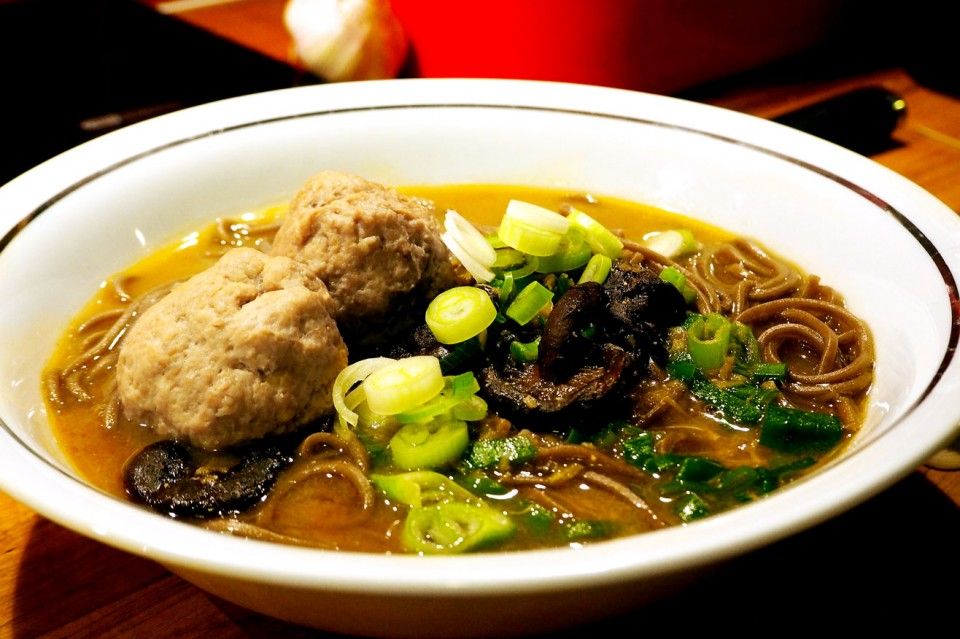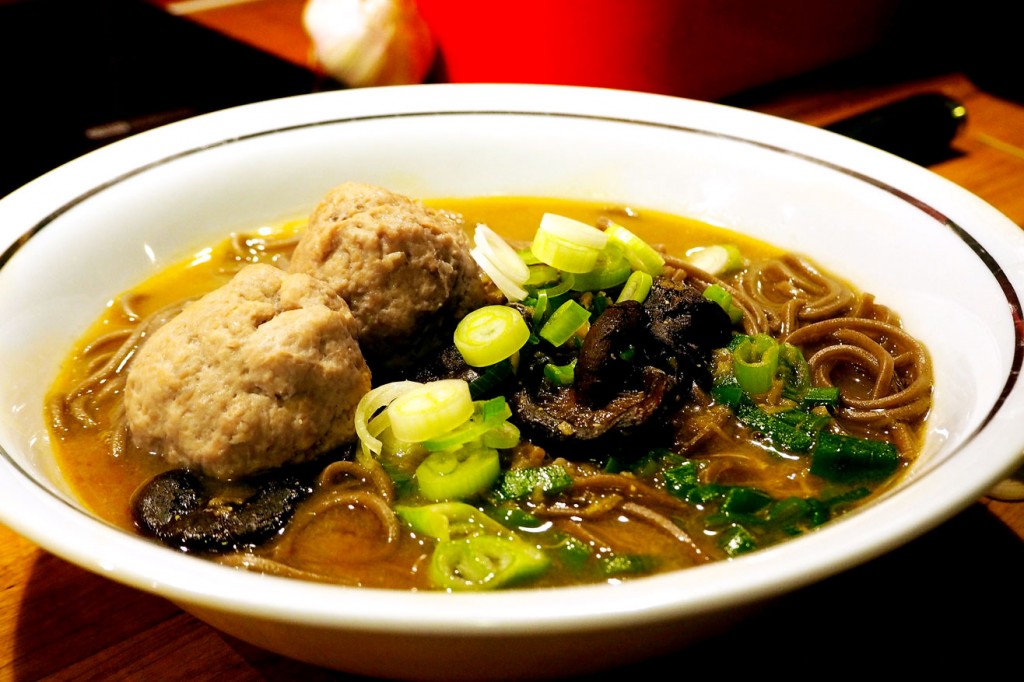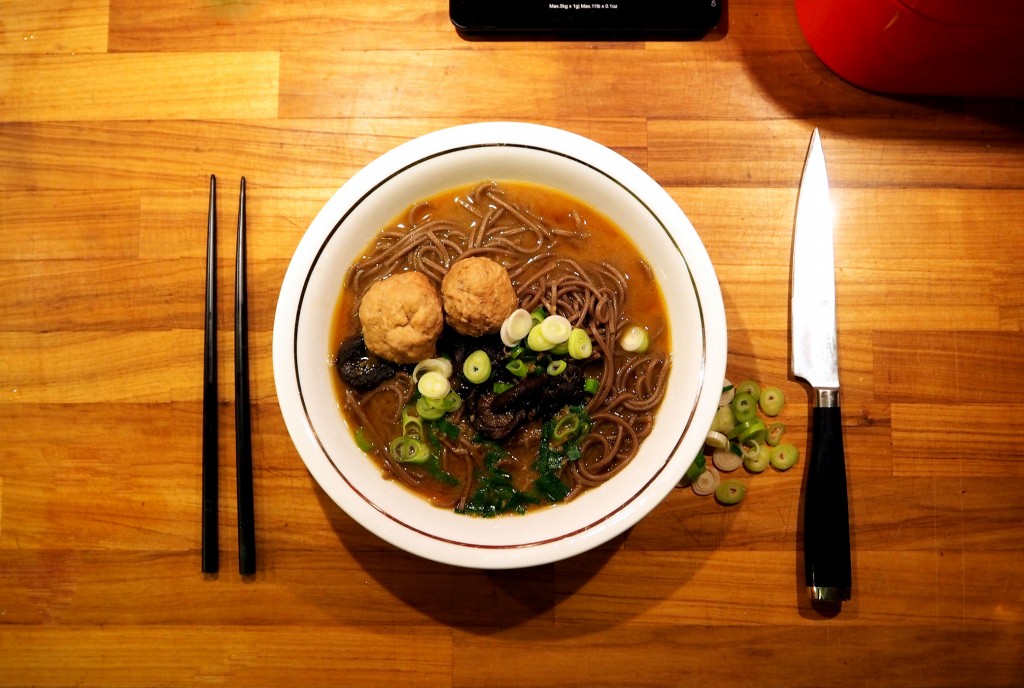Japanese soba with Chinese ground chicken meatballs

Saying you love asian food, is like saying you like European food. What does that even mean, right? Well, I’ll tell you what it means. It means I like the ingredients that are common in many East and Southeast asian regions, those include rice, ginger, garlic, sesame seeds, chilies, dried onions, soy and tofu. And I love the cooking methods, if done well, such as stir frying, steaming and deep frying. Especially steaming. I like the idea of steaming dough, like those Chinese meat-filled buns called baozi. I like how meat is prepared, like drying a duck’s skin before roasting the bird to perfection.
And just like in Europe, exchanges of knowledge between different cultures and cuisines, has resulted in lots of new interpretations of asian classics. And of fusions between different asian dishes, as well as between western and asian cooking. During my trip to China, I noticed that they love western food in general, none the least burgers, but they don’t really merge it with their own food. The Japanese on the other hand, have evolved their traditional dishes. It’s not uncommon to see sushi with mayo and other California style sushi combinations. The French potato croquette is very popular in Japan, and is sold as korokke (コロッケ). You’ll find noodle soups with korokke on top.
With all this having been said, let’s cut to the chase. I wanted to make my own chicken stock and serve it with Japanese buckwheat noodles, called soba. I wanted to include yellow miso paste, made from fermented soy beans. And I wanted to add sesame flavored minced chicken meatballs. Kind of like the Lion’s head (not really a head of a lion) dish popular in Shanghai. It turned out amazingly good!
And I’m normally quite specific when it comes to grams and milliliters, but this time I want you to follow your gut a little more. You might not find the exact same yellow miso paste as I, perhaps yours is a little less salty or a little milder? Then add some more. Perhaps you don’t have a pressure cooker, well then keep boiling the stock until you cant lift the chicken carcass out without it falling apart. Once you have the chicken stock, there aren’t many steps involved in the making. So have faith in yourself!
The recipe yields 4 normal portions or 2-3 really large portions. You’d be surprised how big the bowls of soba soup are in Japan.
The stock itself, is about 6 liters of which two are used for the soup. The rest can be frozen and used later.
Ingredients for Japanese soba with chicken meatballs
- 3 small onions or 2 big ones.
- 2 large carrots
- 8 button mushrooms (these are underrated. Although they’re not very fun to eat by themselves, they are packed with umami, and do help elevate other flavors)
- 16 shiitake mushrooms (yes, you need these, they have a very distinct flavor unlike any other mushroom)
- 5 cherry tomatoes
- 2 garlic cloves
- 1 thumb sized piece of ginger
- 4 tablespoons of yellow miso paste (it’s made from fermented soy beans, and can be found in asian shops)
- 1 scallion (it’s called spring onion in English)
- 250 grams of ground chicken meat (that will make around 6 meatballs)
- 200 grams of soba (Japanese buckwheat noodles)
- sesame oil to taste (i’m using roasted sesame oil, it’s really flavorsome)
- vinegar (i would normally use rice vinegar, but in this recipe I’m using balsamic vinegar, it gives a better flavor in my opinion)
- soy sauce (I’m using the stronger Chinese one, rather than the light Japanese variety)
- 6 liters of water
Instructions for Japanese soba with chicken meatballs
You should really do the stock yourself. Using stock cubes results in a salty broth that isn’t really that good. You can find fresh, ready made broth in some stores. If you really don’t want to make one yourself, at least make sure you get one with no salt added. The yellow miso paste is already salty enough, that you’ll end up with a way too salty dish if you’re not careful.
The chicken stock
- Cut the onions, carrots, and put them into a large pressure cooker.*
- Add the tomatoes, all of the button mushrooms and half of the shiitakes.
- Throw in a chicken carcass.**
- Throw in one clove of garlic, cut into large chunks. That goes for all the vegetables, it’s not really important to mince any of them, they’ll be but a mash after cooking for several hours and/or under high pressure.
- Pour in about 6 liters of water.
- Put on the lid of the pressure cooker, turn on the high-pressure setting, and get the pressure up. Once it starts making sounds, and steam is being forced through the valve, turn the heat down to as low as you can while still maintaining pressure.*** Once you’ve found the lowest heat setting while still retaining the pressure, all you need to do is wait. Let it cook under pressure for 100 minutes. If you don’t have a pressure cooker, you need to cook it for 10 hours. Put on a lid, and make sure to add water if you see that the amount of liquid is reducing to notably lower levels.
- Once the stock is done, run it through a sieve. Make sure to get all that wonderful flavors out of the vegetables, by mashing them with a spoon. Also, make sure to squeeze all the mushrooms. You’ll see a dark brown, almost black liquid coming out of them. Now that’s where the flavor is!
- You have about 6 liters of wonderful stock here. Freeze it, and use it for later. To make this dish, you need about 2 liters of stock. Pour it into a container, cover with plastic wrap, and put it into the refrigerator for about 2 hours. Or over night.
The soup
- Start by cooking the noodles as instructed on the package. Usually around 6 minutes. Then put them in a sieve, get rid of the water, and wash them thoroughly in cold water. Really wash them, like a piece of cloth. We want to get rid of the excess starch, and we want them to be cold to stop the cooking process.
- Take the stock out from the refrigerator. You’ll see that fat has coagulated, and is now floating on the surface. Carefully pour the stock through a sieve, into a saucepan, to get rid of the fat.
- Peel the ginger, and grate it. You’ll be left with some hard fibers in your hand after grating. Before you throw those away, squeeze them. They still have a lot of juice in them.
- Press or grate a garlic clove, and put the ginger, ginger juice and garlic into the stock.
- Throw in the other half of the shiitake mushrooms.
- Add the yellow miso paste. It’s very salty, and should be enough to make the soup perfect. Should you for any reason feel that the dish lacks salt, wait until you’ve added the meat and all the other ingredients, before you start adding more saltiness from say soy sauce.
- Let it simmer while you prepare the meat balls.
The meatballs
- Take about 250 grams of ground chicken meat. Add about half a tablespoon of sesame oil, one tablespoon of balsamic vinegar (yes, balsamic, we’re being transnational here), and a tablespoon of Chinese soy sauce. Mix it thoroughly, and make about six meatballs. Gently drop them into the soup, and let it all simmer for about 20 minutes. Turn the meatballs about half way through. Not because it’s needed for them to get thoroughly cooked, but because I want the whole meatballs to be soaked in soup.
- Chop some scallions, and separate the dark green part from the light part. When it’s about 5 minutes left of the cooking time, put the dark green parts into the soup, and let simmer for the final 5 minutes.
- Now it’s time to try the soup. Is it too salty? Don’t worry just yet, the soba has no salt, and the soup will be great as a whole. As long as you followed my instructions and didn’t add salt anywhere along the way nor used any store bought stock cubes, everything will be fine. Does the soup actually lack salt? In that case add some soy sauce.
- Put the cold soba noodles into a big bowl. Pour over soup together with some of the shiitakes. Put the meatballs on there, and sprinkle the light part of the chopped scallions. And you have it! A delicious plate of soba with chicken meatballs!
Enjoy!
Notes
* If you don’t have a pressure cooker, that’s fine, you’ll just have to cook the stock for much longer.
** If you don’t have one, I recommend you do this recipe for tonight, and save the carcass for tomorrow’s soba dinner.
*** If you turn it down too much, the cooker will no longer make sounds from steam blowing out. If that’s the case, turn the stove back up to maximum, wait until the steam makes its loud noises, then turn down to a little more heat than last time.


